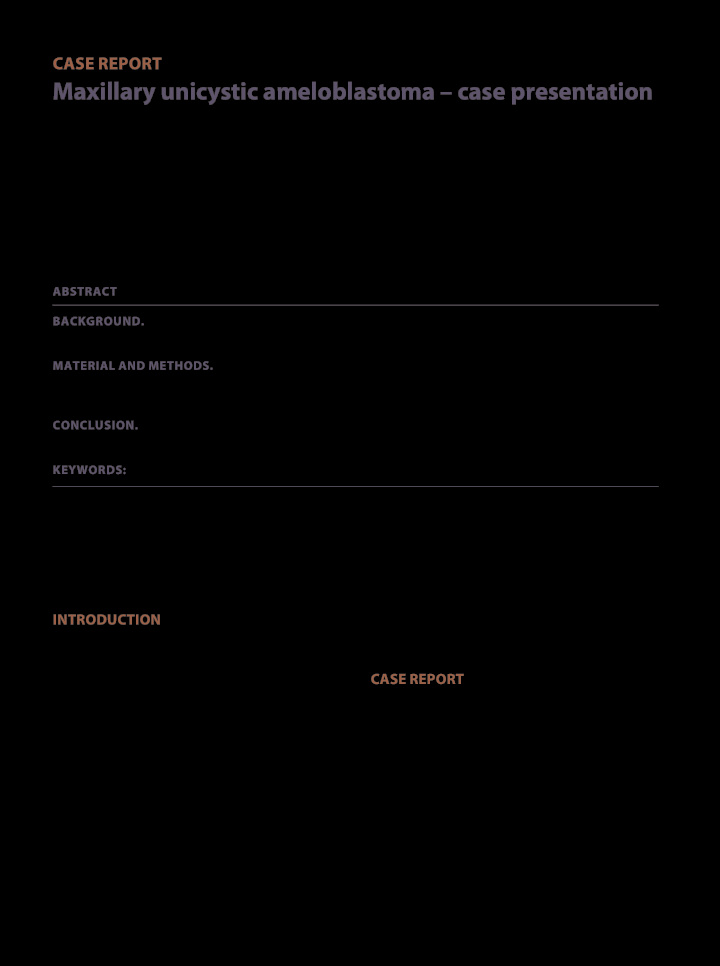



Romanian Journal of Rhinology, Vol. 3, No. 11, July - September 2013 CASE REPORT Maxillary unicystic ameloblastoma – case presentation Raluca Enache 1 , Codrut Sarafoleanu 1,2 1 Sarafoleanu ENT Medical Clinic, Bucharest, Romania 2 “Carol Davila” University of Medicine and Pharmacy, Bucharest, Romania ABSTRACT BACKGROUND. Approximately one fjfth of all neoplasms arising from the embryonic odontogenic apparatus are amelo- blastomas. The origin of ameloblastomas is in the epithelial cells involved in the formation of teeth. The mandible is the most affected site, but maxillary ameloblastoma is the most dangerous kind because of its invasive and aggresive evolution. MATERIAL AND METHODS. A 43-year-old woman was referred to our Department with right nasal obstruction, right sided facial fullness with paraesthesia and chronic frontal headache. The CT scan examination revealed an osseous tumor, with cystic resemblance, arising from the alveolar plate and occupying the right maxillary sinus. Complete removal of the tumor was performed. The histopathological diagnosis was luminal unicystic ameloblastoma. CONCLUSION. Maxillary ameloblastomas are relatively rare tumors, especially the unicystic type, and their high recurrence rate requires complete surgical removal. In case of luminal unicystic ameloblastoma, complete removal of the tumor offers the best hope for cure without radiotherapy or chemotherapy and reduces the recurrence incidence. KEYWORDS: unicystic ameloblastoma, maxilla, luminal type, odontogenic tumor INTRODUCTION surgery; recurrence can occur in 90-100% of situa- tions, in case of incomplete removal 6 . First described by Churchill in 1933, ameloblasto- mas are the most common odontogenic benign tu- CASE REPORT mors with epithelial origin 1,2 . They represent almost 10% of all tumors of the maxilla and mandible, in 80- 85% of the cases involving the mandible and in 15 to A 43-year-old woman was referred to our Depart- 20% the maxilla 3-6 . 50% of the ameloblastomas of the ment with right nasal obstruction, right sided facial maxilla develop in the molar area, involving the maxil- fullness with paraesthesia and chronic frontal head- lary sinus in 15% of the cases 2,6 . ache. Duration of the symptoms was almost two years. Based on the overall histologic architecture, amelo- She underwent different treatments for right chronic blastomas can be divided into three types: solid or rhinosinusitis with no clinical improvement. multicystic, unicystic and peripheral or extraosseous 7 . The ENT clinical examination and nasal endo- The unicystic type of ameloblastoma is more fre- scopic evaluation revealed the congestion of the right quently encountered asymptomatically in the poste- nasal mucosa, with no anterior or posterior discharge rior mandible 7,8 . and no pathologic lesions in the middle meatus. Because of its invasive natural evolution, the treat- The result of the cranio-facial CT-scan showed an ment of choice in maxillary ameloblastomas is radical oval osseous tumor of 18.1/24.4mm, with cystic resem- Corresponding author: Raluca Enache e-mail: enache.raluca@yahoo.com
176 Romanian Journal of Rhinology, Vol. 3, No. 11, July - September 2013 a b c d Figure 1 Cranio-facial CT scan – axial (a,b) , coronal (c) , sagittal (d) slices - oval osseous tumor of 18.1/24.4mm, with cystic resemblance, arising from the alveolar plate and occupying almost entirely the right maxillary sinus. DISCUSSIONS blance, arising from the alveolar plate and occupying almost the entire cavity of the right maxillary sinus (Figure 1a,b,c,d). Approximately one fifth of all neoplasms arising The treatment consisted in Caldwell-Luc approach of from the embryonic odontogenic apparatus are amelo- blastomas 9 . The origin of ameloblastomas is in the the right maxillary sinus, performed under general an- aesthesia (Figure 2), with complete removal of the epithelial cells involved in the formation of teeth (in- tumor. The histopathologic diagnosis was luminal uni- cluding enamel organ, odontogenic rests - cell rest of cystic ameloblastoma, with a hyper-chromatic polarized Malassez, cell rest of Serre, epithelial lining of odonto- genic cyst) 10,11 . basal layer and the overlying epithelium being loosely cohesive and resembled stellate reticulum (Figure 3). The most common type of ameloblastoma origi- The patient’s postoperative evolution was within nor- nates centrally within the bone and tends to be inva- mal limits, with no recurrence at 10 month reassessment. sive and aggressive. Rarely, an ameloblastoma will
Enache et al Maxillary unicystic ameloblastoma – case presentation 177 Figure 2 Endoscopic examination – intraoperatory view Figure 3 Histopathologic examination - ameloblastic epithelium with hyper-chromatic polarized basal layer; the overlying epithelium was loosely cohesive and resembled stellate reticulum.
Recommend
More recommend